Archive for December, 2011
December 29th, 2011 by dave dorsey

Gorky self-portrait
In a painting, you can’t really hide who you are. Your identity is what someone encounters first, looking at your work, and it’s primarily what you’re offering someone who is beguiled by what you do. I’m not sure most criticism would know what to do with this notion: how do you deconstruct another human being’s mind and heart in its entirely? Does it make sense to ask “What does it mean to be Bill Murray?” Sure, if you are asking, what does it entail, in terms of the divorce, the drinking, the toll of all the brilliant acting, but not if you’re asking that question the way you ask “What does that painting mean?” But if the painting is just the man who made it, in microcosm, then how can it make sense to try to extract something out of the painting apart from what you see in it? You can’t break a person down into her constituent parts and explain her away. (Sure wish I could, sometimes.) A whole human being is really what’s secretly being delivered in any work of creative imagination: music, painting, poetry, or fiction. I tried to think about this here a while back but it came and went, inadequately, and I didn’t give it that much more thought because once you say it, what more is there to say? How do you build some critical theory out of, “Hey, I really like that X. I like spending time with that X.” (The way you “like” a person, which is a pretty unfathomable phenomenon.) But this morning, in replying to an email from a good friend, it leaped back up at me and insisted on getting some attention. I wrote this, though I’ve revised it slightly:
Some peoples’ company you enjoy for a little while and then you move on. Then there are some people who are a part of your life permanently from the moment you meet them. I think art is just like that. The work of some artists never loses its mystery and you keep going back for more for as long as you want and it never gets old. Others have an impact on you for a little while and then you grow out of it and wonder why you were so charmed. I think of art as a corollary to friendship and love between individuals, because that’s really what you’re getting in the art: the person himself or herself, along with their values and experiences and wisdom or lack of it, translated into more lasting terms, into sounds or colors and images or words. When I read Salinger, I’m living with Salinger himself, not just his characters. I have him in the room with me–maybe not the whole person but the best of him, the core of his soul–and he’s keeping me company. He’s there with me, my close friend. In a one-directional way, at least. I don’t need anybody else to introduce me to him or what he “means.” I get it. I love the guy. Quit messing with it. To be saying these things is so far outside the way criticism works now, isn’t it? It seems that way to me. Postmodernism is so intentionally sophisticated about explicating what art does and is—yet most of the time what I love just seems simple and direct in the way it reaches me. It’s all about one human being recognizing another human being in the fullest possible sense in the work, whatever the work is, and wanting to spend time listening to, or watching, that other human being, absorbing the way they apprehend and occupy their world. You want to have them close by, sharing your time with you, reminding you of who you are, if you’re lucky.
What that also means to me is that you are the world you inhabit. So when someone responds to you, they are responding to your world, the angle from which you absorb experience, so that they’re seeing the world you see, and that’s magnified or at least made more visible and explicit through art. It’s more common to say, in relation to a novelist, that something is right out of Kafka’s world or Jane Austen’s world, but it’s just as true of painters, that you are in Avery’s world, or Braque’s, or Turner’s, or Giotto’s. So that being in his or her world, you are spending time with that world’s originator, the one who is present everywhere in it, but nowhere visible.
December 27th, 2011 by dave dorsey
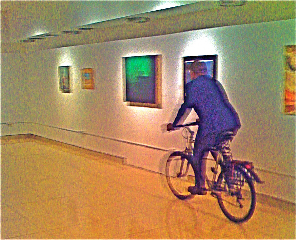
Gorney attending an opening
I spent the morning with AP Gorny last week at a small restaurant in Buffalo. He arrived in the pouring rain on his bicycle. He told me it puts a serious crimp in his ability to get places, but he’s committed to the environment and says he doesn’t want people walking around with oxygen tanks in two generations. Therefore he’s willing to get soaked pedaling around in December. He’s one of those people who looks at every aspect of his life and thinks about the actual outcome of what he does from day to day. We spent two hours together and the conversation wove itself through a variety of different subjects. We almost invariably disagreed and yet I started to find his suppositions thought-provoking and even enlightening.
On the Internet, you’ll have to search hard for any evidence that Gorny actually exists, though a search does yield a few hits, like this one:
Ap Gorny earned an MFA from Yale University. His work is in permanent collections at The Brooklyn Museum, The Victoria and Albert Museum, London; The Solomon R. Guggenheim Museum, New York; Museo de Arte Costarricense, San Jose, Costa Rica; The Philadelphia Museum of Art; The Pennsylvania Academy of Fine Arts; The Franklin Institute; and the National Gallery, Washington, D.C. He is a recipient of major fellowships from The National Endowment for the Arts, Pennsylvania Council for the Arts, and the Pew Fellowships in the Arts.
Not bad for someone who has fled success his entire life. Which is what Gorny maintains he has been doing, both consciously and subconsciously, often by opening his mouth when he probably should have kept it closed. He believes this kind of behavior is instinctive, a path of spiritual survival of sorts. Or, he suggests, maybe what a psychologist would identify as misplaced anger. It’s no accident he isn’t much in evidence in cyberspace. He has tried covering his tracks and values his obscurity, because it’s an element of his entire view that success for an artist is more or less a Devil. That’s a little hyperbolic, intentionally, but not far from the mark.
He’s a reality check for anyone who thinks a painting ought to be an entirely visual form of communication—or that it can be simply a matter of visual sensation. He believes Art is “impurely visual”—more on that in the conversation below. I think of Dave Hickey as a vital critic who has tried to stand apart from 20th century art, to get a clear look at the beast, while calling the entire enterprise into question, yet when I mention his name Gorny dismisses some of Hickey’s views as naïve and wonders why anyone cares what he thinks. “Who cares in the least about a magazine writer? Not a scholar/thinker.” Gorny believes the art world and the “success” it can deliver, often deprives itself and artists of what’s really most essential – the “invisible mental working process of artists reified in their very practice.” So, in most ways, we have little in common in our approach to what art ought to be doing, but More
December 23rd, 2011 by dave dorsey
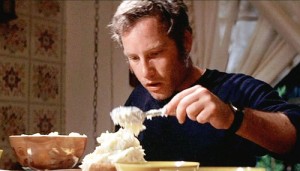
Roy sculpting his potatoes
This is the look of a man in the grip of an inner necessity. Roy builds a mountain of his potatoes and his children weep because he’s clearly nuts as he says: “This is important . . . ”
He just can’t figure out why. (Welcome to a way of life, Roy.) He doesn’t give up until he gets it right–and even then it takes a random, lucky break for him to simply realize that he’s finished sculpting and recognize what he’s been making. Anyone who has seen Close Encounters knows how his instinctive creative obsession leads to a world of experience he couldn’t have guessed would be waiting for him when he started corrugating the sides of his potatoes with a fork at dinner–and (well it’s a Spielberg movie) an invitation into a large, friendly, hovering vehicle glowing like a Christmas tree.
Happy holidays to anyone who still plays with mashed potatoes or other raw materials.
December 21st, 2011 by dave dorsey
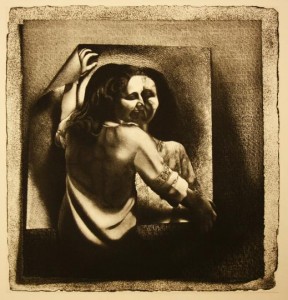
Untitled, AP Gorny
I had breakfast with AP Gorny this morning in Buffalo. His philosophy of art is almost perfectly antithetical to mine, and yet I love talking with someone who can maintain an amiable and perceptive disagreement with me. As William Blake said, “Opposition is true friendship.” He teaches printmaking at Buffalo State University, and he’s a bit of a spark plug when you get him going about the art establishment. I’ll do a post from our talk when I have time to digest it–the conversation ranges far and wide with AP and you realize what he’s giving you is a description of experiences from the perspective outlined in this statement he handed to me, which follows. He’s all about how to be an artist by breaking out of the paradigm of “success” that gets promulgated by nearly everyone in authority. The question of how one manages to keep eating, while righteously pursuing failure, remains a thorny one, I’d say, but I have to admit it’s hard to find fault with what he says here:
From Gorny’s Interdisciplinary Approach to Failure
At this point, in this world I inhabit,
my life is afoot with a program of dismantling
the logic of success/failure.
Artists put themselves
in circumstances purposefully failing,
losing, forgetting, unmaking, undoing,
unbecoming, and not knowing.
In other words, offering creative, cooperative,
surprising, unexpected ways of being in the world.
These particular forms of failure
are more attractive to me than
conventional forms of success,
with ambiguous & wide-rainging consequences.
Providing me with a critique of standardized wisdom-production models
disseminated in university settings that just serve to re-inforce cultural
status quo, I daily propose in appropriate (or inappropriate!)
circumstances, that forgetting and losing knowledge (and all those coded
messages of affluence and success) can lead to developing ideas by way of
such a cultural amnesia.
My interdisciplinary approach to failure, obviously leads to problems,
not just in awful academia; it opens a morass negotiating daily life. But I
just say: Like a plumber’s work, it’s a dirty job, but somebody has to do it.
–AP Gorny 11.11.11
December 21st, 2011 by dave dorsey
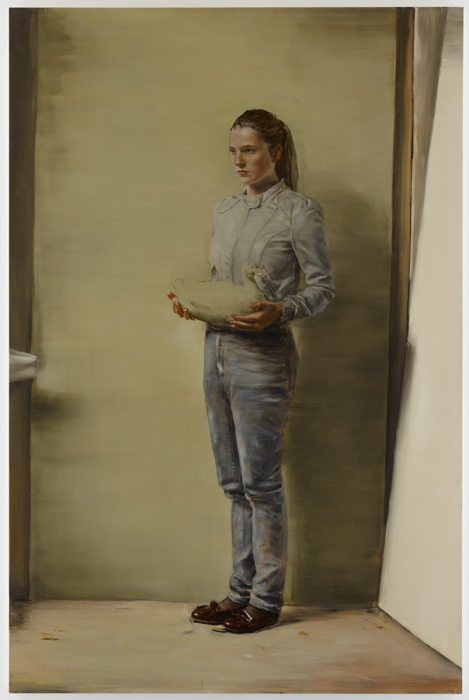
Girl with Duck, Michael Borremans
Last Thursday, two days before the Michael Borremans show closed, just under the wire, more or less, I finally slipped into Zwirner to see it. I was on a quick tour of Chelsea galleries with my young friend from Ohio, Rush Whitaker—who rooms in Brooklyn with Lauren, the subject of my last post, as well as with Krystal Floyd, another young Midwesterner struggling to make it as an artist in New York. When he isn’t painting or writing letters to Taylor Swift, Rush works as a security guard at the Metropolitan Museum. He’s both a writer and an artist and a genuinely warm, totally honest individual who has learned some sort of emotional ju jitsu that turns all the negative energy around him into a fuel for contentment and generosity. He’s also kind of gigantic, at around 240 pounds of genetically bestowed body mass, with some rounded edges from the beer—all of which is to say so he can afford to be indifferent to the slings and arrows of the average day. He has nothing to prove. Still, I’m baffled at how unflappable and cheerful he is, whenever I see him. He’s completely unlike the classic, moody, self-involved egotist an artist is supposed to be. He was astute when it came to the work we looked at—we wandered through more than a dozen galleries, and glanced into many others without going in. We’d just visited David Zwirner’s adjoining gallery where Neo Rausch’s work was on display, and where I was finding Rausch’s images more and more disorienting and nightmarish, the longer I looked at them. Gazing into those scenes, you think there’s something just fundamentally, metaphysically wrong with human experience. Row row row your boat, he says, it won’t matter; life is but a fever dream. Rush couldn’t get enough of those paintings, moving up close, standing back, picking apart the physics of Rausch’s imaginary world and totally getting into it. I just wanted out of there. I wish I’d paid less attention; I would have enjoyed that work more. (The work is fine. I just didn’t want to stay in his world for long. Make of that what you will.)
Walking into the Borremans show . . . man oh man. There’s mastery and then there’s Mastery. Borremans makes it look as if he almost has other things on his mind as he dashes off these figures set in ambiguous, spare rooms, and yet More
December 13th, 2011 by dave dorsey
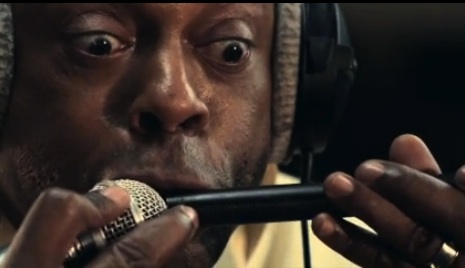
Michael Winslow on the mic
I’m passing along this video of actor Michael Winslow impersonating the history of the typewriter, which I got recently, as a subscriber to The Very Short List, which sends me a marvelous daily email about imaginative little gems in the vast ocean of the Web. (Sadly, though I get interesting alerts to books, movies and music, the visual arts seem underrepresented there, as they so often are as a subject of interest to your average Web surfer.) Winslow had a role in Police Academy as Larvell “Motor Mouth” Jones. Here he seems somehow to have physically assimilated an entire sequence of typewriters into his body, so that when he creates the sound of someone typing tentatively on one of them, he looks like a man possessed and the effect is beyond uncanny. It’s a little chilling and, eventually, inspiring. At the beginning of the video, Winslow looks as if he’s gathering all his inner ch’i, eyes closed, solar plexus locked into a crunch, to actually imprint words on paper with nothing but the sound emerging from his lips. You find yourself forgetting everything else that ought to be commanding your attention and listening to the magic of keys hitting paper on platen, followed by the incredible scriiiick of the carriage return. It’s a different set of sounds with every single typewriter he imitates. It’s as if he’s been close friends with each one of these machines for half his life. I wonder if most people who click to this video have even heard a typewriter being used, much less an old manual one, except in the movies, but if you have, you’ll agree this little performance is a wonder of mimesis. There’s an element of reverent nostalgia in all this for me, because I miss typewriters, the terrible sense of commitment to each word they entailed with all that heavy impact that could leave a little image of each letter in a sort of braille on the reverse side of the paper. (I mean terrible because who wanted to pick up one of those little eraser wheels with the stiff black bristles on one end and put that to use? Oh, and then came salvation for those of us challenged in the work ethic department, the “correcting Selectric” with the sticky tape that would lift errant words right back off the paper.) Woody Allen has used the same ancient manual typewriter to commit everything he’s ever written to paper, and he gets around the problem of erasers by actually cutting and pasting rectangles of new paper, with new words, over the old ones–as he demonstrated in the recent PBS biography of him. Winslow conveys a lot of that slow, deliberate sense of one-hard-word-after-another in the pace of his imitation, and his imaginary words emerge into the air with the random cadence of corn just starting to pop.
I’m offering this little video because it brought to mind, for me, two things. One was the sensation I got when I first read Nicholson Baker’s The Mezzanine, which I’ve mentioned before here–the way in which he could take the most ordinary details of a routine lunch break and render them fascinating by bringing a new level of microscopic focus and attention to them. It also reminded me of the sensation of looking at an incredibly detailed painting and how it can create a thirst to see more simply by presenting assiduously rendered details, which have no conceptual value or worth, but, because they’ve been brooded upon for hours or days or weeks by an artist, seem to shine with an original kind of interest and value. Recently, Derek Wilkinson’s self-portrait at Manifest, had this effect: it made me marvel at the complexity of color in human skin, seeming to capture the way light reflects off the surface, but also at deeper layers, where the colors deepen and change hue. Representational painting is, in varying degrees, an act of mimesis akin to what Winslow does here, and at its best, it makes you want to return to the world and just look or listen, and be more intensely aware of whatever is simply there. The downside for me in all of this is that now I want to help revive the economy by spending money I don’t have on this.
December 13th, 2011 by dave dorsey
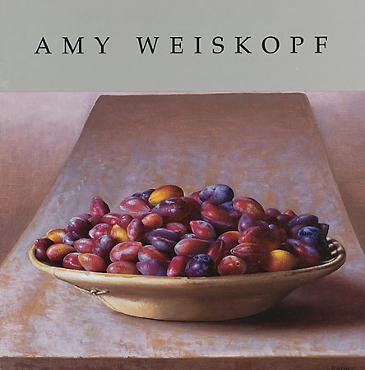
“Today’s art world is wildly eclectic and every artist must make stylistic choices that indicate philosophical positions. I finished school in the early 80’s. At that time art tended to be more conceptual than visual. Sociopolitical issues outweighed aesthetics. Beauty, admittedly difficult to define, was considered elitist, trite, shallow, and inextricably tied to white European men. Pleasure, an equally slippery concept, was not discussed much. My reaction was to move to Italy where I spent the next 9 years looking at what those white European men, and a few women, had done. Call it the aesthetic experience, the pleasure created by a visual image, a nonverbal image, is particular and intense. In a personal and fairly empirical fashion I went looking for that experience, noticed when it happened, and tried to analyze why. For myself, the pleasure in looking is the fundamental force behind the power of visual arts. I believe painting can provide a particularly complex, therefore, pleasurable experience. This complexity is the result of highly orchestrated visual contrasts: spacial, tonal, chromatic and textural. I am a strict formalist; the structure of the painting creates the visual pleasure. I found still life the most suitable genre for organizing these effects. The sheer joy of looking at the painting, that visual and visceral understanding, so difficult to define, should never be eclipsed by more tangible considerations.”
Any Weiskopf, from Painting Perceptions
December 11th, 2011 by dave dorsey
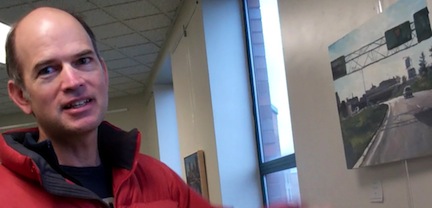
Jim Mott at High Falls gallery
If anyone represents the ideal of what it should mean to be an artist right now, it’s Jim Mott. It may, in fact, be an impossible ideal, but for the past twelve years, Mott has been living an itinerant life, driving around the country with almost no cash, and doing paintings for anyone who offers hospitality. It’s a model of the painting life that takes money almost completely out of the picture. American Artist has written about him, and his last journey, in 2007, from Seattle to Rochester, attracted attention from The Christian Science Monitor and The Today Show. On his trips, he uses cash to pay for nothing but gas. In fact, he convinced a judge in Missoula to take a painting as payment for a speeding ticket. Two prints got him a room in Yellowstone Park. Mostly, though, he arranges to stay at homes and spends enough time there—being fed and kept warm by his hosts—to do a set of small premier coup oil paintings, mostly of nondescript, but nonetheless beautiful, scenes in and around that home. They are done rapidly, intuitively, in the manner of the little sprigs of asparagus that Manet once painted as a gift for a collector who’d bought a larger painting.
Mott’s work reminds me of what Fairfield Porter’s body of work might look like, if he had relied on gray more than he did—in other words, if he’d settled here in the upstate corridor of Buffalo, Rochester and Syracuse, where gray skies are the default backdrop for life. He has the same generalized execution, the same feel for the most mundane moment of the day, the unspectacular and overlooked scene. Mott works small, mostly on little rectangles of conservation board, and he sometimes finishes two paintings a day, and when he succeeds, the image has the kind of life that Hockney celebrated in the book Hand, Eye and Heart, back when he was on his campaign against the use of cameras as a tool for painters. Mott’s work is about creating form through the juxtaposition of values and suggestion, not detail and definition, and it’s as much about the evidence of gesture, the energy embodied in the act of putting paint on a surface—“the scale of these paintings is perfect for the kind of marks I’m making”—as it is about the scene itself. He works in gray and then applies color sparingly—and often with wonderful subtlety—toward the end of the painting session.
“When things work out with a painting, I don’t know how,” he says, “and I never know if I’ll be able to do it again. I’m an anxious painter. I know what’s possible, and I’m never sure how to make it happen. I don’t really like to paint. I like it when the painting’s done. But it can feel worthwhile.”
I met Mott a couple of weeks ago, at lunch and then got together for a look at his current solo show at High Falls gallery, here in Rochester. More
December 7th, 2011 by dave dorsey
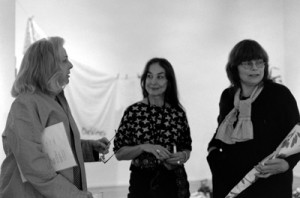
Janet Bohman, Vernita N'Cognita, May Deviney at Viridian
After helping her and a couple other fellow artists hang the new show at Viridian Artists this past weekend, I sat down with Vernita N’Cognita at a little gourmet pizza place around the corner, just off 10th Avenue. She’s been associated with the gallery for more than a decade and is now its director. I consider her the presiding spirit of compassion in that little gallery, someone who has a cool sense of humor and a warm heart. She changed her name from Vernita Nemec to Vernita N’Cognita as an homage to the “unknown artist,” which is consistent with her vocation as director of exhibit space for those who aren’t represented by more commercial galleries. As an artist, she’s built a long-standing reputation in branches of art I know much less about than painting: performance, installations, collage. She was a part of the SoHo scene in the early 70s when it was just emerging, and has been a recognized figure ever since—she’s still being invited to perform in spaces at various sites around the world, though she’s never achieved fame or earned much for her work. She comes from a Catholic family in Ohio, raised by what sounds like a pair of caring, attentive parents, her mother a housewife and her father a tradesman, and this upbringing has been the subject of some of her most interesting and lyrical performances—which are invariably about the way it feels to be a woman in contemporary America. She calls herself a feminist artist, yet when she describes her work, it sounds more subtle and literary than polemical. What I took away from our conversation was a sense, now more than ever, that an artist needs to define the nature of “success” and what it means in a personal way. In most cases, it can’t be about money, nor even about the scope of one’s audience: artistic integrity might ultimately depend on being able to make a living doing something else. And not ordering the tenderloin.
Vernita: When I started out, I lived on 11th. Then on Christopher. Now on Canal St., where I’ve lived for a thousand years. I was mostly painting and doing installations. My first gallery was SOHO20, one of the first feminist galleries. I’m still on their board of directors. Actually, I’m curating a 40-year retrospective for them. After I left SOHO 20, I showed in colleges and other alternative spaces. Then at Gallery 128 on the Lower East Side. Now, in addition to Viridian, I curate a restaurant in Queens. Restaurants make sense except for the fact that the work smells like food. (She laughs) I did a show there and I made my price list like a menu: appetizers, main course and dessert. I ran this arts organization called Artists Talk on Art, which was an historically important organization for ten years. You don’t get money for any of these things, but it broadened my reputation. People think I’m a helper for artists.
As Lauren Purje pointed out, there isn’t just one art world.
People forget that Mary Boone went to RISD and the guy who wears the bathrobe and makes films. . .
Schnabel.
Julian. She went to school with him. So of course he shows in her gallery.
You almost have to define what you mean by success.
Exactly.
Some artists don’t want a gallery to exert control over what they do. You have to figure out how to make money. How have you done it all these years? More
December 6th, 2011 by dave dorsey

It's all about the Woodrows. My iPhone shot of the High Line billboard on 10th
From Jerry Saltz today in New York magazine:
It looks like the art world has entered an ugly finger-pointing period. Call it the Shoot the Wounded Phase: Players at the top are starting to accuse each other of being craven, cronyistic bad actors. Everyone knows something bad is brewing, that some end or explosion is imminent amid the obscene prices, profligate spending, celebrity-artist worship, obnoxious behavior of the rich, and art as entertainment. People are showing up to say, “It wasn’t me. It was him! It was her! It was them!” A few days after Adam Lindemann’s (scathing) column (in the New York Observer) came out, the mega-mogul super-collector Charles Saatchi stepped into the arena, publishing an article in the Guardian. “Being an art buyer these days is comprehensively and indisputably vulgar … the sport of the Eurotrashy, Hedge-fundy, Hamptonites; of trendy oligarchs and oiligarchs; and of art dealers with masturbatory levels of self-regard.” Saatchi goes all out in his attack of the “stupendously rich,” saying they don’t actually “enjoy looking at art” and instead “enjoy having easily recognized, big-brand name pictures, bought ostentatiously in auction rooms at eye-catching prices, to decorate their several homes, floating and otherwise, in an instant demonstration of drop-dead coolth and wealth. Their pleasure is to be found in having their lovely friends measuring the weight of their baubles, and being awestruck.” A much better writer, collector, and thinker than Lindemann, and far more honest, Saatchi gets a lot right about ‘the success of the uber art dealers [being] based upon the mystical power that art now holds over the super-rich.” But he never turns his grand-inquisitor beam on himself, or explains how, somewhere along the line, he went off-track and lost his eye. He himself originated, and has long been the top player in, this terrible business. Good writing aside, it may be that this multimillionaire is a little upset that he’s being displaced by multibillionaires.
December 3rd, 2011 by dave dorsey

Michael Heizer's rock
Rick Harrington sent some of his fellow painters a column from Mother Jones, about a landscape installation in Los Angeles, suggesting we could hash out, at our next lunch, what the writer, Kevin Drum, is ranting about. The column is a classic reaction to a lot of modern and contemporary art: why is this art? A book could be written about why this question is maybe the only one that matters right now, both to those who think an unhewn rock, an object found in nature, could serve as art, and for those who think it’s a fraud. I think the more interesting question lies in this fellow’s common assumption that one needs an advanced education to appreciate art, which is part of what’s embedded in that query about the nature of art. I don’t think anyone would argue with the fact that you need a bit of study to appreciate art now. When it comes to a lot of what’s emerged over the past century, you need to know how art evolved in the West over the past two thousand years or you can’t fully understand what has happened to art in the 20th and 21st centuries. This isn’t the case with Greek sculpture, or Giotto, or the Sistine Chapel, or Bruegel, or Vermeer . . . you can pick when you think the shift happened, but it’s most likely in the 19th century. My sense, though, is that the more you need a specialized education to appreciate a work of art, the less natural its impact seems to be. It might be a brilliant act of imagination once you grasp the thinking behind it, but should that thinking be required? Does it matter, except in some other realm, such as politics. Is the need for this kind of study a good thing? That doesn’t get raised here, explicitly, but it’s implied. My sense is that, judging from the drawing of this particular rock, I’ll love the way it will look in front of the Los Angeles County Museum of Art. It’s simple: I like that boulder. But is it art? I don’t really care, except that if the answer is no, I resent that the artist is getting paid more than a landscaper would. And you can count on that: undoubtedly he’ll get a satisfactory percentage of the cost of transporting the rock to L.A. from its origin in Riverside County. The bill will be $10 million, and will be paid by private donors. Is it art? (I imagine Sir Lawrence Olivier asking Dustin Hoffman this question over and over, as a prelude to more dental work in Marathon Man. Slide show rotating with images from Jenny Holzer projected onto the wall of the cell. Is it art? Yes it’s art! Yes yes yes! Oh God, yes! If Duchamp’s urinal is art, so is the boulder! Any oil of cloves left?) The most common reaction to all this is that the project’s absurdity is Sisyphean, except that the rock won’t be rolling back to where it started. And this takes you back to the original question: what is art? It depends on how you define the word. The boulder strikes me, personally, as a Ripley’s Believe It or Not element of landscape design, more than a work of art—though the way I react to a Japanese rock garden would qualify it as a work of art. Is this a stalemate?
If you go back far enough, say around two centuries ago—and at any time prior to that—people didn’t ask themselves whether something was a work of art, but whether or not it was a good one. When I started this blog, and mostly while writing it, I’ve limited myself to talking about painting, though not entirely. I did this partly because I’m a painter and partly as a way of avoiding this question of what qualifies as art. Painting is much easier to define than art as a whole. No one argues that paintings are works of art. The only question is that venerable one: is it any good? The fallback, if you want to be a reactionary and dismiss a lot of what’s happened since the advent of Modernism, would be to say art needs to be, in some degree, visually representational. When what was represented by art began to favor concepts, rather than perceptions, a lot of the interest in looking got lost. (No ideas but in things!) You see a horizon line in Rothko. You can see a flower in Stella’s minimalism. You see a woman in De Kooning. You see a pedestal table in Braque. The leap is bigger in some cases than others. Yet the further you get from visual representation, it seems, the less you want to keep going back for a second or third helping: it just gets less and less interesting, when you lose that tension between what’s happening on the surface and what’s being represented. The bottom line, in all of this, is: how often will I want to look at that rock?
What really irked Drum, in Mother Jones, was the verbiage that served as justification for the rock: “Taken whole, Levitated Mass speaks to the expanse of art history from monolithic stone, to modern forms of abstract geometries and cutting-edge feats of engineering.” The vague all-encompassing hyperbole put him off, understandably, though as art PR goes, it sounds fairly comprehensible, the usual anodyne boilerplate meant to elevate the proceedings: the verbal equivalent of helium. Drum, though, really savages this forgettable little sentence by dissecting it and showing how little it actually conveys. His key point is this: “Installations like this are the kind of thing that’s divorced the art world from the vast majority of modern-day audiences.” There’s the rub. This is the legacy of Modernism: as a consequence of the way Western art has evolved over the past two centuries, art now inhabits a tony intellectual and economic ghetto which seems to get smaller and smaller, the gated community of the most privileged, both in wealth and education. Drum isn’t the only one who finds this intolerable.
December 1st, 2011 by dave dorsey
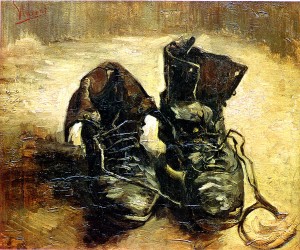
Van Gogh, Pair of Shoes, 1886
Below are several quotes about how art can embody an immediate intuition of the whole of life, and they deserve more attention than appearing in a list here, which is all I can manage at the moment. All three of these writers suggest that visual art can convey far more than it ostensibly is showing you, on its surface. Not metaphorically, but through a purely sensory impression. These three suggest that sensory experience can convey something more encompassing than conceptual knowledge, more subliminal, and more inclusive and unifed—the awareness of the world’s wholeness. Becket tries to explain how this works, in purely psychological terms, and in extremely recondite language, in his essay on Proust. All of these writers suggest something that seems to me alien to much of what’s been implicit in the tradition of Western painting, if not in the practice of it, certainly in the intellectual theorizing that usually runs parallel alongside it. It’s actually closer to traditions of Chinese and Japanese painting.
Harper’s did a funny commentary on the Heidegger quote and how it gave rise to even less comprehensible passages from postmodern theorists, who adopted the German thinker’s practice of inventing their own difficult language to convey their ideas. For example, I’m not sure why he needed “attain to unconcealedness” when “reveal” would seem to do just as well. It would have been so much clearer if he’d simply said: “Looking at the pair of shoes Van Gogh painted, you don’t simply see the objects, but you see the months and years of labor in the fields, the weather of different seasons, the passage of time . . . the entirety of the life built around the protection they offered to a worker’s feet.” In other words, the shoes in Van Gogh’s painting do what landscape paintings more often do: awaken the sense of an entire life, the passing seasons, the passage of time. Something along those lines might have won Heidegger more readers, but mostly he preferred to stick to his oracular pose. These quotes also tangentially remind me of T.S. Eliot’s famous remark about Henry James: “He had a mind so fine no idea could violate it.” It’s always struck me as a quote just as applicable to many of the greatest painters.
Truth happens in Van Gogh’s painting. . . This does not mean that something is correctly represented and rendered here, . . . (it) does not mean that something which is at hand is correctly portrayed, but rather that in the revelation. . . . of the shoes . . . world and earth in their counterplay attain to unconcealedness . . . this shining, joined in the work, is the beautiful. Beauty is one way in which truth essentially occurs in unconcealedness.
—Heidegger, The Origin of the Work of Art
And as soon as I had recognized the taste of the piece of madeleine soaked in her decoction of lime-blossom which my aunt used to give me . . . in that moment all the flowers of our garden and in M. Swann’s park, and the water-lilies on the Vivonne and the good folk of the village and their little dwellings and the parish church and the whole of Combray and its surroundings, taking shape and solidarity, sprang into being, town and garden alike, from my cup of tea.
—Proust
The most successful evocative experiment can only project the echo of a past sensation, because, being an act of intellection, it is conditioned by the prejudices of the intelligence which abstracts from any given sensation, . . . whatever word or gesture, sound of perfume, cannot be fitted into the puzzle of a concept. But the essence of any new experience is contained precisely in this mysterious element that a vigilant will rejects as an anachronism . . . no amount of voluntary manipulation can reconstitute in its integrity an impression that the will has—so to speak—buckled into incoherence. But if, by accident, . . . . the central impression of a past sensation recurs as an immediate stimulus which can be instinctively identified by the subject . . .then the total past sensation, not its echo or copy, but the sensation itself, . . . . comes in a rush to engulf the subject in all of the beauty of its infallible proportion.
The most trivial experience . . . is encrusted with elements that logically are not related to it and have consequently been rejected by our intelligence . . . (therefore) Proust does not deal in concepts, he pursues . . . the concrete. He admires the frescoes of the Paduan Arena because their symbolism is handled as a reality, special, literal and concrete, and is not merely the pictorial transmission of a notion.
Lying in bed at dawn, the exact quality of the weather, temperature and visibility, is transmitted to him in terms of sound, in the chimes and the calls of the hawkers.
—Samuel Beckett











